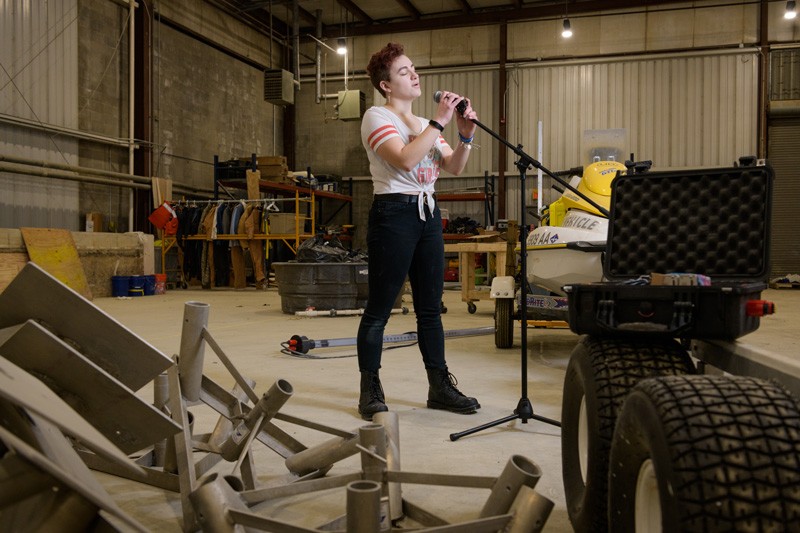UD senior Sydney Cargill melds her two passions: science and song
Sydney Cargill spends a lot of time with a 10-foot tube. More specifically, it’s a clear PVC pipe with a strip of plastic and some wires inside. When she carts it around or hovers over it in a laboratory, she’s usually singing whatever upbeat song happens to be in her head at the time.
It’s not like she serenades the tube. Mostly, she sings for her own pleasure. Still, it’s not what you would expect to hear in a scientific setting.
“I definitely get quieter when other people are close,” she said with a laugh. “It can be embarrassing.”
No, Cargill is not a mad scientist. She is just your typical (okay, maybe not-so-typical) singing engineer.
“People are surprised to hear I do both,” said the University of Delaware senior. “But I’ve learned you don’t have to pick only one thing — science or art or anything else. Do what you love. Your interests don’t have to make sense.”

Sydney Cargill sings an a capella version of Adele’s “Skyfall” on stage at the Gore Recital Hall.
If anyone’s qualified to talk both cadenzas and cantilevers, it’s Cargill. She started singing at the age of four, and she joined her first choir at 10. In middle school, she played the flute. In high school, the baritone. Now, between analyzing data for her civil engineering major, she rehearses at least six hours per week with DelReMi, a student a capella group at UD. Last year, she served as assistant music director. This year, she is treasurer.
The rest of the world may find these two interests — science and song — a weird pairing. But it’s possible they aren’t all that far removed after all.
“With singing, you have to know your part, but you also have to listen to everyone else and make sure you’re blending in,” Cargill said. “That teamwork is important in engineering, too. In one of my classes, we’re designing a sports complex. Each student team includes members from different engineering disciplines — structural, environmental, transportation and civil. For the final product to be cohesive, everyone has to come together.”
Cargill’s participation as an alto in DelReMi also helps inform her undergraduate research, which she is completing outside of her regular studies through UD’s world-renowned Center for Applied Coastal Research.

Sydney Cargill, pictured here in UD’s Coastal Engineering Lab, is using a solar array, equipped with 30 sensors that detect light, to study the movement of sand during heavy wave action on a beach. The results could be used by town and resource managers in strategizing best ways to mitigate erosion.
Take that giant PVC pipe she’s been (figuratively) attached to since the fall of last year. The device, which was built on campus, is what’s called a photocell array. In other words, it’s equipped with 30 sensors — four centimeters apart — that detect light. When you partially bury this array in the sand on a beach, these sensors help determine the movement of sediment underwater during heavy wave action. This is important, because while measuring the shape of a beach’s profile before and after a storm is relatively easy, monitoring the exact movement of sand in the midst of a weather event has always been trickier — only a handful of researchers in the country are even attempting it. Such data could, potentially, have big implications.
“Understanding the physics behind how a beach behaves will enable us to develop improved prediction tools,” said Jack Puleo, director of the Center for Applied Coastal Research and Cargill’s adviser. He also occasionally sings — poorly, he insists — while working. “Output from these tools will enable town and resource managers to identify, in the event of a storm, which areas are most likely to suffer severe erosion. They’ll be able to make informed decisions about where to pre-place assets — say, sandbags or a bulldozer — in anticipation.”
But plunging sensitive scientific equipment into the ocean can be risky business. Cargill ran into trouble when figuring out how to keep the data loggers attached to her photocell array from banging around inside their waterproof box. Until, that is, she went to a few DelReMi rehearsals and came up with a solution: wooden dividers she went on to build with another undergraduate student.

Sydney Cargill, member of the a capella group DelReMi, says she’s “transported to a different world” when she sings, which she does even while at work in the Coastal Engineering Lab, pictured here.
“When I’m stuck on a problem, taking the time to make music helps me get unstuck,” Cargill said. “It helps me to think outside the box and stay creative, and there’s definitely creativity involved with engineering.”
Up until this point, all of Cargill’s work with the photocell array has happened in a controlled laboratory setting, including the three months she spent last summer at Oregon State University studying sediment dispersal in a wave flume that mimicked a Jersey Shore beach during Hurricane Sandy. Later this semester, she and Puleo will attempt their first field experiment with the equipment in Bethany Beach, as soon as conditions are just stormy enough. Before the end of the year, Cargill will compile all her data into a senior thesis — with lots of singing breaks built in, of course.
“To me, the science is excitement,” she said. “But the music? That’s tranquility.”
As for what comes next? Cargill is not entirely sure, although graduate school for aerospace engineering has piqued her interest.
“I’d love to be part of moving our species forward in that realm,” she said. “And I know the skills I’ve learned at UD will help me get there.”
In the meantime, only one thing is certain.
“No matter what I end up doing, music will be part of it,” Cargill said. “I’ll never stop singing.”
| Photos by Evan Krape

